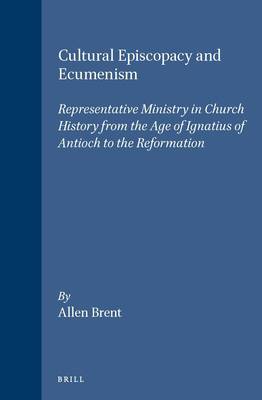
- Afhalen na 1 uur in een winkel met voorraad
- Gratis thuislevering in België vanaf € 30
- Ruim aanbod met 7 miljoen producten
- Afhalen na 1 uur in een winkel met voorraad
- Gratis thuislevering in België vanaf € 30
- Ruim aanbod met 7 miljoen producten
Zoeken
Cultural Episcopacy and Ecumenism
Representative Ministry in Church History from the Age of Ignatius of Antioch to the Reformation. with Special Reference to Contemporary Ecumenism
Revd Allen Brent
€ 267,45
+ 534 punten
Omschrijving
Bishops are to be understood primarily as representatives of cultures regardless of where their people are territorially located. The vindication of this thesis has implications also for ecumenical reconciliation between episcopal and non-episcopal communions occupying the same geographical territory.
The author compares the approaches and insights of both Vatican II and Lambeth 89 on this issue, and then proceeds to a historical and theological analysis of the development of the threefold Order in the early centuries, which he illuminates with the aid of contemporary sociological and cultural theory, in particular that of Durkheim. Key themes in the development of Order are identified in the classical texts of Ignatius of Antioch, Irenaeus, Cyprian, Tertullian and the Church Order literature.
The author's conclusion is that we need both to break the geographical and jurisdictional mould in which our understanding of church Order has become set.
The author compares the approaches and insights of both Vatican II and Lambeth 89 on this issue, and then proceeds to a historical and theological analysis of the development of the threefold Order in the early centuries, which he illuminates with the aid of contemporary sociological and cultural theory, in particular that of Durkheim. Key themes in the development of Order are identified in the classical texts of Ignatius of Antioch, Irenaeus, Cyprian, Tertullian and the Church Order literature.
The author's conclusion is that we need both to break the geographical and jurisdictional mould in which our understanding of church Order has become set.
Specificaties
Betrokkenen
- Auteur(s):
- Uitgeverij:
Inhoud
- Aantal bladzijden:
- 268
- Taal:
- Engels
- Reeks:
- Reeksnummer:
- nr. 6
Eigenschappen
- Productcode (EAN):
- 9789004094321
- Verschijningsdatum:
- 1/03/1992
- Uitvoering:
- Hardcover
- Formaat:
- Genaaid
- Afmetingen:
- 164 mm x 246 mm
- Gewicht:
- 607 g

Alleen bij Standaard Boekhandel
+ 534 punten op je klantenkaart van Standaard Boekhandel
Beoordelingen
We publiceren alleen reviews die voldoen aan de voorwaarden voor reviews. Bekijk onze voorwaarden voor reviews.








